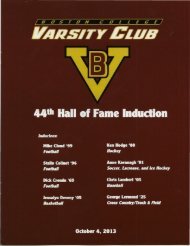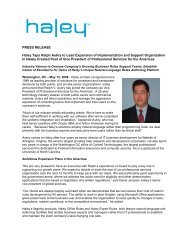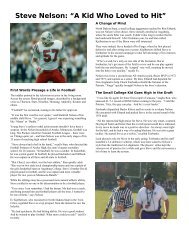42nd Hall of Fame Induction - Graber Associates
42nd Hall of Fame Induction - Graber Associates
42nd Hall of Fame Induction - Graber Associates
Create successful ePaper yourself
Turn your PDF publications into a flip-book with our unique Google optimized e-Paper software.
PETE OLIVIERI ’65, MBA ’66Honorary2010 INDUCTEELate one Friday after noon in September <strong>of</strong>1980, the phone rang in the ComputerScience <strong>of</strong>fice. The Boston College athleticdepartment had just received a new wordprocessor to drive the stadium’s messageboard. Was there somebody up there whocould plug the mysterious device in and getit to work?Pr<strong>of</strong>essor Peter Olivieri took a walk down tothe press box. He hooked up a couple <strong>of</strong>wires, flipped a switch, and by golly, theblack board sprang to incandescent life. Hehad opened the door to a brave new world atAlumni, which had been the last major collegestadium to switch from an analog clockto a digital one.Stanford was in town for a game, and therewas no one to operate the board. Pete corralledMIS guru Bernie Gleason to help out,and the two <strong>of</strong> them had a ball. They got thecrowd roaring with giant-fonted exhortationslike “NOISE!” and “STAMP YOUR FEET.” Ithelped, also, that the victory-starved fanssaw Coach Eddie Chlebek’s team blow thefavored Cardinal away 30-13, the third homewin in the last dozen tries.That launched a fruitful, fun-packed 28-yearrelationship between the BC High kid fromSomerville and Eagle sports. Every new generation<strong>of</strong> digital display and game-day electronicmedia, from that time to the present,has been overseen by Pete Olivieri:Scoreboard entertainment, digital specialeffects, season highlight videos, statisticaldisplays that update with every recordedshot, point, yard gained or pass completed,were the handiwork <strong>of</strong> Pete and his team.Pete established and managed the VideoControl Room at Conte Forum. He trainedan enthusiastic cadre <strong>of</strong> student volunteers,kids from all majors and disciplines, todesign and operate the displays.Olivieri was intensely involved behind thescenes too. One day he asked coach TomCoughlin if he had a way to track how closelyopposing teams followed the game planthat BC coaches had predicted from watchingvideotapes. Tom, who was nothing if notwell prepared in his approach to games, toldhim no.Peter went to the coaches’ box and observedhow they scrambled to predict opponents’formations by using charts and whiteboards.He wrote a laptop program that quantifiedthe probabilities <strong>of</strong> upcoming <strong>of</strong>fensive formations.The coaches loved it, and for threeyears Pete traveled with the team until theNCAA banned computers in coaches’ boxesand locker rooms. Boston College had beenthe only school using a computer to aid thecoaching staff during a game.The Big East also issued a rule banning thegrading <strong>of</strong> basketball players. This cameabout after Pete started displaying opponents’academic letter grades for foul-shootingpercentages.Pete was also responsible for leading suchinnovations as scoreboard-mounted camerasabove the hockey goals, wireless microphones,and a helmet-mounted camera fortraining quarterbacks to recognize defensivealignments.Pr<strong>of</strong>essor Olivieri was a faculty member for40 years, joining the school just as the informationage got underway. He taught subjectssuch as management Information Systems,Digital Special Effects, and programming.He also was known for performing magictricks midway through class lectures.Another <strong>of</strong> Pete’s singular achievements washis involvement in the “Eagle Eyes” project.Pete and colleagues Jim Gips and Joe Teccehad been batting around basic researchthoughts on communication between computersand humans. They wanted to find away to play Pong, the primitive video game,by using eye movements instead <strong>of</strong> hands.One day, someone noted that a few <strong>of</strong> thecampus school students, who were paralyzedfrom the neck down, could benefit from sucha capability. It was simple for Pete and Jimto write a program to drive a head-mountedcomputer control system. It translated eyemovements to commands that made on-screen button clicks.The story <strong>of</strong> Michael Nash and the EagleEyes is especially inspiring. Michael was 11years old, paralyzed and unable to walk orspeak. He had been diagnosed with aninfant’s intelligence level. His motherrefused to believe the diagnosis and wouldnot send him to an institution. She boughtMichael to BC, where he proceeded to correctlyanswer a series <strong>of</strong> questions aboutmany things that his mother had told himand taught him over the years. Michaelcaught up with his contemporaries and,aided by the Eagle Eye and tests translatedto multiple choice by volunteer BC students,graduated from high school.Pete wasn’t originally a math or tech enthusiast.He went to BC High on a grant fromthe Eagles Foundation, which helped thechildren <strong>of</strong> servicemen who died in WorldWar II. He found his calling when heencountered BC faculty member Al Simone,an MIT-educated management pr<strong>of</strong>essor whois now president emeritus <strong>of</strong> RochesterInstitute <strong>of</strong> Technology.Simone got Pete got hooked on computers,programming, and the application <strong>of</strong> math toreal-world problems. Pete got his MBA at BCand a Ph.D. at Columbia, took care <strong>of</strong> hisArmy ROTC commitment by working oncomputers at the Pentagon, then returned toChestnut Hill in 1970. He has taught atleast 10,000 students, managed video operationsat more than 1,000 sporting events,and helped hundreds <strong>of</strong> handicapped peoplelive happier, more productive lives throughthe use <strong>of</strong> technology.Pete is still researching the nexus <strong>of</strong> technologyand humanity; he’s investigating howto control <strong>of</strong> devices through brain waves –such as turning on the television by justthinking about it.Pete met his wife Rita when she was workingat a Brigham’s. He says he hung aroundthe place so much that the manager gavehim a job. She is a nurse who has threedegrees from BC. They both retired fromfulltime faculty duties last year. Their sonScott is director <strong>of</strong> web development at theuniversity, and daughter Julie directs trainingand communications for the IT department.The Olivieri family, including in-laws,has totaled more than 125 years <strong>of</strong> serviceto the school and holds 13 degrees.Pete’s license plate is “BC One” and Rita’s is“BC BC.”“Cut us, and we’ll bleed maroon,” he says.27







